66 Cancri is a binary star system near the northern border of the zodiac constellation of Cancer, located 474 light years away from the Sun. It is visible to the naked eye as a faint, white-hued star with a combined apparent visual magnitude of 5.87. The pair are moving closer to the Earth with a heliocentric radial velocity of −13 light years. As of 2003, the magnitude 8.56 companion was located at an angular separation of 4.43″ along a position angle of 134° from the primary.

NGC 2976 is a peculiar dwarf galaxy in the northern circumpolar constellation of Ursa Major. It was discovered by German-born astronomer William Herschel on November 8, 1801, and catalogued as H I.285. J. L. E. Dreyer described it as, "bright, very large, much extended 152°, star involved". It is a member of the M81 Group and lies 1° 20′ to the southwest of Messier 81. The projected separation of this galaxy from the M81 Group is 190 kpc.

NGC 4605 is a dwarf barred spiral galaxy in the constellation Ursa Major, located at a distance of 18.1 ± 0.3 megalight-years from the Milky Way. Physically it is similar in size and in B-band absolute magnitude to the Large Magellanic Cloud. It is a member of the M81 Galaxy Group, along with Messier 81 and Messier 101.

NGC 5962 is a spiral galaxy in the equatorial constellation of Serpens Caput. It was discovered by the Anglo-German astronomer William Herschel on March 21, 1784. The NGC 5962 galaxy is located at a distance of 120 million light years and is receding with a heliocentric radial velocity of 1,957 km/s. It is the brightest member of the eponymously-named NGC 5962 group, which overlaps with the nearby NGC 5970 group; the two groups may be gravitationally bound.
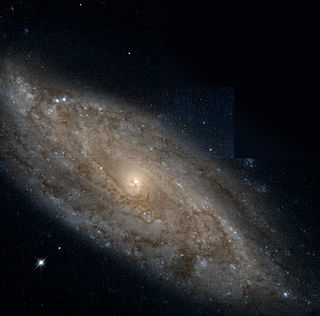
NGC 7314 is a spiral galaxy located in the southern constellation of Piscis Austrinus. It was discovered by English astronomer John Herschel on July 29, 1834. This is a nearby Seyfert (active) galaxy, located at a distance of approximately 54.6 megalight-years from the Milky Way. Since it appears to have detached spiral arm segments, it was listed in Halton Arp's Atlas of Peculiar Galaxies.
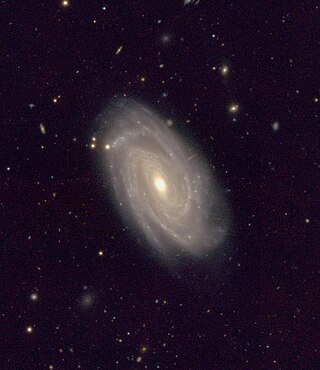
NGC 10 is a spiral galaxy located in the southern constellation of Sculptor. It was discovered by John Herschel on 25 September 1834. The galaxy is located at a distance of 346 Mly from the Sun. Its morphological classification in the De Vaucouleurs system is SAB(rs)bc, where the 'SAB' denotes a weak-barred spiral, '(rs)' indicates a slight ring-like structure, and 'bc' means the spiral arms are moderately to loosely wound. Paturel et al. (2003) assigned this galaxy a classification of SBbc, indicating a barred spiral galaxy.

NGC 63 is a spiral galaxy in the constellation Pisces. NGC 63 is its New General Catalogue designation. It has an apparent V-band magnitude of 12.70.

NGC 73 is an intermediate spiral galaxy estimated to be about 350 million light-years away in the constellation of Cetus. It was discovered by Lewis A. Swift from the USA in 1886 and its apparent magnitude is 13.7.
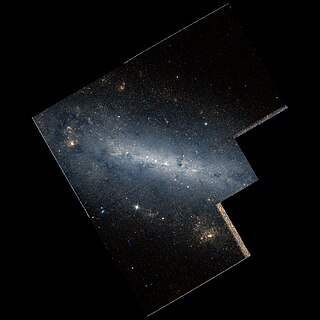
NGC 672 is a spiral galaxy in the northern constellation of Triangulum, positioned around 2° to the southwest of the star Alpha Trianguli. The original object designated NGC 672 was discovered by the German-born astronomer William Herschel on 26 October 1786, but this was later cataloged as NGC 614. The object now identified as NGC 672 was discovered by John Herschel on 11 November 1827.

NGC 1792 is a spiral galaxy located in the southern Columba constellation. It was discovered by Scottish astronomer James Dunlop on October 4, 1826. This galaxy is located at a distance of about 36.4 million light-years and is receding from the Milky Way with a heliocentric radial velocity of 1,208 km/s. NGC 1792 is a member of the NGC 1808 cluster of galaxies.

NGC 2992 is a Seyfert galaxy located 103 million light years distant in the equatorial constellation of Hydra. It was discovered in 1785 by Anglo-German astronomer William Herschel.
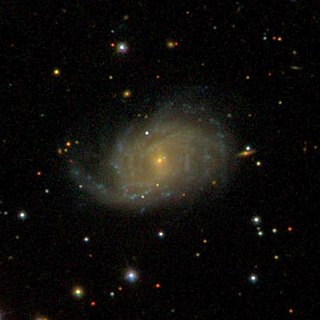
NGC 7046 is a barred spiral galaxy located 193 million light-years away in the constellation of Equuleus. With a high radial velocity of 4,130 km/s, the galaxy is drifting away from the Milky Way. NGC 7046 has an apparent size of 0.990 arcmin, and at its current distance, it has an estimate diameter of 192,639 light years. NGC 7046 has a morphological type of "SBc", which indicates that it is a barred spiral galaxy with a definite bulge.
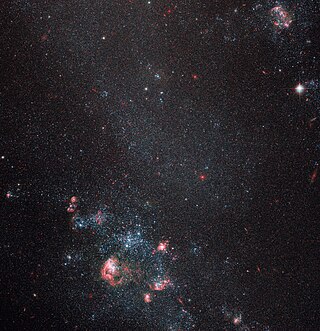
IC 2574, also known as Coddington's Nebula, is a dwarf spiral galaxy discovered by American astronomer Edwin Foster Coddington in 1898. Located in Ursa Major, a constellation in the northern sky, it is an outlying member of the M81 Group. It is believed that 90% of its mass is in the form of dark matter. IC 2574 does not show evidence of interaction with other galaxies. It is currently forming stars; a UV analysis showed clumps of star formation 85 to 500 light-years in size.
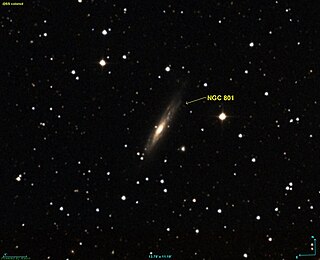
NGC 801 is a spiral galaxy with an active galaxy core in the constellation Andromeda. It is estimated to be 174 million light-years from the Milky Way and has a diameter of approximately 174,400 light-years. The object was discovered on September 20, 1885 by the American astronomer Lewis A. Swift.

NGC 840 is a barred spiral galaxy in the constellation Cetus south of the ecliptic. It is estimated to be about 300 million light-years from the Milky Way and has a diameter of approximately 175,000 ly.

NGC 912 is a compact lenticular galaxy located in the constellation Andromeda about 197 million light years from the Milky Way. It was discovered by French astronomer Édouard Stephan in 1878.

NGC 1325 is a flocculent spiral galaxy situated in the constellation of Eridanus. Located about 75 million light years away, it is a member of the Eridanus cluster of galaxies, a cluster of about 200 galaxies. It was discovered by William Herschel on 19 December 1799.

NGC 3818 is an elliptical galaxy in the Constellation Virgo. It is at a distance of about 118 million light-years away from Earth. In the center of NGC 3818 lies a supermassive black hole. NGC 3818 was discovered by William Herschel on March 5, 1785.

NGC 1172 is an elliptical galaxy in the constellation Eridanus. It was discovered by William Herschel on December 30, 1785.

NGC 1570, mistakenly called NGC 1571, is a faint galaxy located in the southern constellation Caelum, the chisel. It has a blue magnitude of 13.2, making it visible through a medium sized telescope. Based on a redshift of z = 0.014760, the object is estimated to be 198 million light years away from the Local Group. It appears to be receding with a heliocentric radial velocity of 4,392 km/s.



















